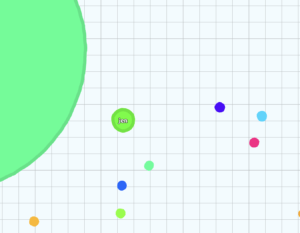A game I have loved recently is Agar.io. The premise of the game is as follows: you are a circular cell traveling around a map representing a petri dish. Your objective is to gain as much mass as possible by consuming smaller static blobs (called agar) representing cells smaller than your own cell while avoiding larger cells, which can consume your own cell. Each player starts with one cell, but upon reaching critical mass, can expand into two cells. You must also avoid viruses, which split your cells into smaller cells, rendering them more vulnerable to being eaten by other players.

Aesthetically, the game pursues challenge, fellowship, discovery, and submission. The game emphasizes the challenge of making it on to the leaderboard, asking players to directly compete against one another by forcing them to literally consume one another to double, triple, and quadruple their own mass. Consuming agar is not fast enough, to become the largest bacteria as quickly as possible, you must consume other bacteria. Additionally, the game pursues fellowship to a lesser degree, allowing offline friends to join the same room and compete against one another. The game emphasizes discovery to a lesser degree as well, incorporating a corner map encouraging players to roam around the limited circular petri dish and discover other players around them. Finally, the game pursues submission, since game controls are quite simple, as you only need to navigate aimlessly around the map with a simple mouse pointer leading your cell. Quite frequently, my friends and I would log on to Agar.io to drift around, looking for one another as pastime.

Mechanically, there exists a dynamically changing leaderboard, the players can view only a limited section of the petri dish at a time, players have the option to split into fractions of their cell size upon having reached a critical mass to move faster, and smaller cells move faster than larger cells, and cells are guided by a single mouse pointer. The limited window into the petri dish available makes the experience an exciting one, where the viewers have no idea what’s around the bounded corner, if they might run into a larger cell and have to turn away the other direction, or if they might chase a smaller cell to consume. The ability to split into fractions of the cell size and the functionality of having smaller cells move faster than larger cells gives users the ability to evade and escape, making the dynamics of the game one of strategy, evasion, and chase, with plenty of user control.


